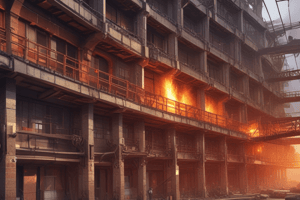Podcast
Questions and Answers
What is the most commonly used classification system for fires?
What is the most commonly used classification system for fires?
- NFPA D
- NFPA X
- NFPA A (correct)
- NFPA Z
Which material is inherently fire resistant due to its chemical composition?
Which material is inherently fire resistant due to its chemical composition?
- Metals
- PVC
- Gypsum wallboard (correct)
- Plastic
Why are plastic and PVC not recommended for structural purposes?
Why are plastic and PVC not recommended for structural purposes?
- They are cost-prohibitive
- They are too heavy
- They are highly flammable (correct)
- They are earthquake-prone
Which type of metal is generally safe to use in fire-prone areas?
Which type of metal is generally safe to use in fire-prone areas?
What is the purpose of fire-resistant doors in buildings?
What is the purpose of fire-resistant doors in buildings?
Why are fire escape plans essential in buildings?
Why are fire escape plans essential in buildings?
Which class of fire involves combustible metals like magnesium and aluminum?
Which class of fire involves combustible metals like magnesium and aluminum?
What is the main characteristic of a Class K fire?
What is the main characteristic of a Class K fire?
Which type of fire involves energized electrical circuits?
Which type of fire involves energized electrical circuits?
What is the main characteristic of a Class C fire?
What is the main characteristic of a Class C fire?
Which class of fire involves flammable liquids like oil and gasoline?
Which class of fire involves flammable liquids like oil and gasoline?
What do flammability ratings classify materials based on?
What do flammability ratings classify materials based on?
Flashcards are hidden until you start studying
Study Notes
Introduction
Fire safety is of utmost importance in any building, whether residential or commercial, to protect lives and minimize property damage. One critical aspect of fire safety is ensuring that materials used in construction can withstand high temperatures without igniting or melting. This article will discuss various aspects of fire safety, including material resistance to fire, types of fires, flammability ratings, and common practices in fire safety design.
Types of Fires
Fires are classified based on their characteristics so that appropriate measures can be taken to extinguish them effectively. These classifications include Class A, B, C, D, E, and K:
- Class A: Ordinary combustibles such as wood, paper, and cloth
- Class B: Flammable liquids like oil, gasoline, and paint thinners
- Class C: Electrical equipment, wiring, and circuit breakers
- Class D: Combustible metals, such as magnesium, aluminum, and titanium
- Class E: Energized electrical circuits
- Class K: Cooking oils and fats
Flammability Ratings
Flammability ratings classify materials based on their ease of ignition and rate of combustion. The most commonly used classification system is the National Fire Protection Association (NFPA) ratings of A, B, and C:
- NFPA A: Self-extinguishing when ignition source is removed
- NFPA B: Self-extinguishing for certain distances, but not for others
- NFPA C: Self-extinguishing with ignition source removed, but requires an external means to extinguish
Material Resistance to Fire
Material resistance to fire is crucial in understanding what materials can be used in construction without posing a risk of ignition or contributing to rapid fire spread. Some materials, such as gypsum wallboard, are inherently fire resistant due to their chemical composition and have fire resistance ratings. Other materials, like plastic and PVC, are highly flammable and should not be used for structural purposes.
Gypsum Wallboard
Gypsum wallboard, also known as sheetrock, is a popular building material due to its cost, ease of installation, and fire resistance. It is made by sandwiching a layer of gypsum between two layers of paper or fiberglass. The gypsum core is a fire retardant, making gypsum wallboard highly resistant to combustion.
Plastic and PVC
Plastic and PVC are commonly used materials, but they are highly flammable. When exposed to high heat, they can melt and release toxic fumes, making them dangerous for use in fire-prone areas.
Metals
Metals, especially those with low melting points like aluminum, can be problematic in fire situations as they can ignite and release toxic fumes. However, higher-melting-point metals like stainless steel are generally safe to use in fire-prone areas.
Fire Safety Design Practices
Fire safety design practices are essential for minimizing the risk of fire and ensuring that occupants can safely evacuate a building in case of a fire. These practices include:
- Fireproof walls: Fireproof walls are designed to resist fire for at least 2 hours, providing a barrier against fire and reducing the likelihood of it spreading.
- Fire-resistant doors: Fire-resistant doors are designed to slow down the spread of fire and provide a barrier to protect occupants.
- Fire suppression systems: Fire suppression systems, such as sprinklers and fire alarms, are crucial for detecting and extinguishing fires before they become uncontrollable.
- Fire escape plans: Having a well-planned fire escape plan in place is essential for ensuring that occupants can safely evacuate a building in case of a fire.
Conclusion
Fire safety is a critical aspect of building design and construction. Understanding material resistance to fire, types of fires, and flammability ratings are essential for designers to create structures that can withstand fire and protect occupants. By implementing fire safety design practices, such as fireproof walls, fire-resistant doors, and fire suppression systems, buildings can be made safer for their occupants in case of a fire.
Studying That Suits You
Use AI to generate personalized quizzes and flashcards to suit your learning preferences.




